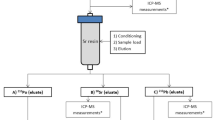Abstract
The quantification of radioactive material dispersed following the release of 90Sr, whether accidental or intentional, would be of high importance. Depending on the circumstances, it is possible that the contaminated materials would need to be completely digested prior to quantification. Many sample matrices require a mixture of different acids be employed to achieve total dissolution. Unfortunately, one the most common approaches for the separation of strontium, extraction chromatography with Sr Resin, has only been fully characterized in pure mineral acid solutions (Filosofov et al. in Solv Extr Ion Exch 33(5): 496–509, 2015; Horwitz et al. in Solv Extr Ion Exch 10(2): 313–336, 1992). This work shows that Sr Resin can be used effectively with high concentration mixtures of nitric and hydrochloric acids in the presence or absence of hydrofluoric acid, thereby potentially negating the need for conversion to a pure mineral acid matrix.




Similar content being viewed by others
References
Baum EM, Ernesti MC, Knox HD, Miller TR, Watson AM (2010) Nuclides and isotopes chart of the nuclides, 17th edn. Bechtel Marine Propulsion Corporation, Schenectady, NY
National Research Council (2008) Radiation source use and replacement: abbreviated version. The National Academies Press, Washington, DC
Grigoriev A, Katashev A (2012) RTG disposal program in Russia: status of RTG decommissioning activities, Moscow
Ferguson CD, Kazi T, Perera J (2003) Commercial radioactive sources: surveying the security risks. Monterey Institute of International Studies, Monterey, CA
Frost RM (2005) Dirty bombs: radiological dispersal and emission devices. Adelphi Pap 45(378):75–78
Human Health Fact Sheet: Strontium (2001)
ATSDR (2004) Toxological profile for strontium, 2004th edn. U.S. Department of Health & Human Services, Atlanta
Driver CJ (1994) Ecotoxicity literature review of selected Hanford site contaminants. Pacific Northwest Laboratory, Richland
Andersson KG, Mikkelsen T, Astrup P, Thykier-Nielsen S, Jacobson LH et al (2009) Requirements for estimation of doses from contaminants dispersed by a ‘Dirty Bomb’ explosion in an urban area. J Environ Radioact 100:1005–1011
Farfán EB, Gaschak SP, Maksymenko AM, Donnelly EH, Bondarkov MD et al (2011) Assessment of 90Sr and 137Cs penetration into reinforced concrete (extent of “deepening”) under natural atmospheric conditions. Health Phys 101(3):311–320
Reshetin VP (2005) Estimation of radioactivity levels associated with a 90Sr dirty bomb event. Atmos Environ 39(25):4471–4477
Steeb JL, Graczyk DG, Tsai Y, Mertz CJ, Essling AM et al (2013) Application of mass spectrometric isotope dilution methodology for 90Sr age-dating with measurements by thermal-ionization and inductively coupled-plasma mass spectrometry. J Anal At Spectrom 28(9):1493–1507
Varga Z, Wallenius M, Mayer K, Keegan E, Millet S (2009) Application of lead and strontium isotope ratio measurements for the origin assessment of uranium ore concentrates. Anal Chem 81(20):8327–8334
Horwitz EP, Chiarizia R, Dietz ML (1992) A novel strontium-selective extraction chromatographic resin. Solv Extr Ion Exch 10(2):313–336
Vajda N, Kim C-K (2010) Determination of radiostrontium isotopes: a review of analytical methodology. Appl Radiat Isot 68:2306–2326
ASTM (2012) Standard test methods for chemical analysis of carbon steel, low-alloy steel, silicon electrical steel, ingot iron, and wrought iron. ASTM International, New York
ASTM (2014) Standard test methods for chemical analysis of stainless, heat-resisting, maraging, and other similar chromium-nickel-iron alloys. ASTM International, New York
ASTM (2012) Standard test method for radiochemical determination of strontium-90 in soil. ASTM International, New York
Maxwell SL, Culligan B, Hutchison JB, Utsey RC, Sudowe R et al (2016) Rapid method to determine actinides and 89/90Sr in limestone and marble samples. J Radioanal Nucl Chem 310(1):377–388
Morrison SS, Beck CL, Bowen JM, Eggemeyer TA, Hines CC et al (2017) Determination of tungsten in geochemical reference material basalt Columbia River 2 by radiochemical neutron activation analysis and inductively coupled plasma mass spectrometry. J Radioanal Nucl Chem 311(1):749–754
Seiner BN, Morley SM, Beacham TA, Haney MM, Gregory S et al (2014) Effects of digestion, chemical separation, and deposition on Po-210 quantitative analysis. J Radioanal Nucl Chem 302(1):673–678
Currie LA (1968) Limits for qualitative detection and quantitative determination. Application to radiochemistry. Anal Chem 40(3):586–593
Filosofov DV, Lebedev NA, Radchenko V, Rakhimov AV, Happel S et al (2015) Behavior of actinium, alkaline, and rare earth elements in Sr-resin/mineral acid systems. Solv Extr Ion Exch 33(5):496–509
Horwitz EP, Dietz ML, Fisher DE (1990) Correlation of the extraction of strontium nitrate by a crown ether with the water content of the organic phase. Solv Extr Ion Exch 8(1):199–208
Jakopic R, Benedik L (2005) Tracer studies on Sr resin and determination of 90Sr in environmental samples. Acta Chim Slov 52(3):297–302
Acknowledgements
This material is based upon work supported by the U.S. Department of Homeland Security under Grant Award Number, 2012-DN-130-NF0001. The views and conclusions contained in this document are those of the authors and should not be interpreted as representing the official policies, either expressed or implied, of the U.S. Department of Homeland Security.
Author information
Authors and Affiliations
Corresponding author
Rights and permissions
About this article
Cite this article
McLain, D.R., Liu, C. & Sudowe, R. Using Sr Resin with mixed acid matrices. J Radioanal Nucl Chem 316, 485–490 (2018). https://doi.org/10.1007/s10967-018-5778-4
Received:
Published:
Issue Date:
DOI: https://doi.org/10.1007/s10967-018-5778-4




